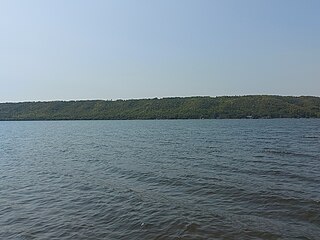
The Missionary Oblates of Mary Immaculate (OMI) is a missionary religious congregation in the Catholic Church. It was founded on January 25, 1816, by Eugène de Mazenod, a French priest later recognized as a Catholic saint. The congregation was given recognition by Pope Leo XII on February 17, 1826. As of January 2020, the congregation was composed of 3,631 priests and lay brothers usually living in community. Their traditional salutation is Laudetur Iesus Christus, to which the response is Et Maria Immaculata. Members use the post-nominal letters, "OMI".

Fort Qu'Appelle is a town in Canadian province of Saskatchewan located in the Qu'Appelle River valley 70 km (43 mi) north-east of Regina, between Echo and Mission Lakes of the Fishing Lakes. It is not to be confused with the once-significant nearby town of Qu'Appelle. It was originally established in 1864 as a Hudson's Bay Company trading post. Fort Qu'Appelle, with its 1,919 residents in 2006, is at the junction of Highway 35, Highway 10, Highway 22, Highway 56, and Highway 215. The 1897 Hudson's Bay Company store, 1911 Grand Trunk Pacific Railway station, Fort Qu'Appelle Sanatorium, and the Treaty 4 Governance Centre in the shape of a teepee are all landmarks of this community. Additionally, the Noel Pinay sculpture of a man praying commemorates a burial ground, is a life-sized statue in a park beside Segwun Avenue.
Frederick Sasakamoose, was a Canadian professional ice hockey player. He was one of the first Canadian Indigenous players in the National Hockey League, and the first First Nations player with treaty status. He played 11 games with the Chicago Black Hawks during the 1953–54 season; the rest of his career, which lasted from 1953 to 1960, was spent in various minor leagues. After his playing career, Sasakamoose became involved in Indigenous affairs, and served as chief of the Ahtahkakoop Cree Nation for a period. He was later recognized for his work, including being named a member of the Order of Canada.

The Fishing Lakes, also called the Calling Lakes or the Qu'Appelle Lakes, are a chain of four lakes in the Qu'Appelle Valley cottage country about 40 miles (64 km) to the north-east of Regina in the Canadian province of Saskatchewan. The lakes are in a region called the Prairie Pothole Region of North America, which extends throughout three Canadian provinces and five U.S. states. It is also within Palliser's Triangle and the Great Plains ecoregion. The Fishing Lakes all follow the course of the Qu'Appelle River, which flows from the west to the east and is part of the Hudson Bay drainage basin. The lakes sit in the deep-cut Qu'Appelle Valley that was formed about 14,000 years ago during the last ice age. Meltwater from the glaciers carved out the valley and as water levels rose and fell, alluvium was left in the wake. These piles of alluvium are what created the separations between the lakes.
Noel Victor Starblanket was a Canadian politician. For two terms from 1976 to 1980 he was chief of the National Indian Brotherhood.

Division No. 6 is one of eighteen census divisions in the province of Saskatchewan, Canada, as defined by Statistics Canada. It is located in the south-central part of the province. The most populous community in this division is Regina, the provincial capital.

Lebret is a village in the Canadian province of Saskatchewan within the Rural Municipality of North Qu'Appelle No. 187 and Census Division No. 6. The village is situated on Mission Lake of the Fishing Lakes in the Qu'Appelle Valley. Lebret is located along Highway 56, about 70 km (43 mi) northeast of the City of Regina. The village was named after "the parish priest, Father Louis Lebret, who became the first postmaster of the community and, although he only held the position for a little more than six months, the office was named Lebret and the name became that of the community."

The Athol Murray Trophy is a Canadian ice hockey series to determine the Saskatchewan Junior B championship and seed of the Keystone Cup - the Western Canada Junior "B" Hockey Crown.

The Rural Municipality of North Qu'Appelle No. 187 is a rural municipality (RM) in the Canadian province of Saskatchewan within Census Division No. 6 and SARM Division No. 1. It is located in the south-east portion of the province.

Cowessess First Nation is a Saulteaux First Nations band government in southern Saskatchewan, Canada. The band's main reserve is Cowessess 73, one of several adjoining Indigenous communities in the Qu'Appelle Valley. The band also administers Cowessess 73A, near Esterhazy, and Treaty Four Reserve Grounds 77, which is shared with 32 other bands.

Star Blanket Cree Nation is a First Nations band government in Saskatchewan, Canada. Its reserves are in the Fort Qu'Appelle area. The Star Blanket Cree Nation is one of the bands covered by Treaty 4.
Arthur "Art" Obey was a Canadian ice hockey coach with the Lebret Indians. While Obey coach them Lebret Indians, they dominated amateur hockey for five years. He was a participant in multiple sports and twice received the Tom Longboat Award. He went on to work in sports and recreation at various locations in Saskatchewan, including initiating the Indian Summer Games in that province. He is considered a "builder and leader in recreation and sport development for Aboriginal people."
Herbert Strongeagle is considered "a role model for 'breaking the stereotype, myths and perception of Native people that is constantly reinforced by hockey people and the media" by his community, and in 2006 received the First Nations Lifetime Achievement Award - Saskatchewan. Early in his life he was awarded the Tom Longboat Medal as Best Indian Athlete in Saskatchewan for his contributions to his junior baseball and midget and juvenile hockey teams, along with track and field and basketball, and continued to receive awards from his community for contributions through his lifetime.
George Lawrence Poitras, Paskwaw-Mostos-Kapimotet was a teacher and later Chief of the Peepeekisis Cree Nation.
Gordon's Indian Residential School was a boarding school for George Gordon First Nation students in Punnichy, Saskatchewan, and was the last federally-funded residential school in Canada. It was located adjacent to the George Gordon Reserve.

Wa-pii-moos-toosis 83A is an Indian reserve of the Star Blanket Cree Nation in Saskatchewan. In 2016, its Community Well-Being index was calculated at 61 of 100, compared to 58.4 for the average First Nations community and 77.5 for the average non-Indigenous community. The name of the locality means "White Calf".
The Canadian Indian residential school gravesites are burial areas for an unknown number of students that died while attending the Canadian Indian residential school system. Comparatively few cemeteries associated with residential schools are explicitly referenced in surviving documents; however, the age and duration of the schools suggests that most had a cemetery associated with them. Most cemeteries were unregistered, and as such the locations of many burial sites of residential school children have been lost. The Truth and Reconciliation Commission of Canada has called for "the ongoing identification, documentation, maintenance, commemoration, and protection of residential school cemeteries or other sites at which residential school children were buried."
The Muscowequan Indian Residential School was a school within the Canadian Indian residential school system that operated on the lands of the Muskowekwan First Nation and in Lestock, Saskatchewan, from 1889 to 1997.

Mission Lake, also known as Lebret Lake, is a lake in the Canadian province of Saskatchewan. It is one of four lakes in the Qu'Appelle Valley known as the Fishing Lakes. Echo Lake is upstream and Katepwa Lake is downstream. The lake was named Mission after the Catholic mission at Lebret. Highways 22 35, and 56 provide access to the lake.

Margaret R. Cote, was a Canadian educator, author, linguist, and historian. A Saulteaux, she is best known for her work concerning the preservation of Western Ojibwe and culture, as well as being the first teacher in Saskatchewan to teach a First Nations language in a public school.













